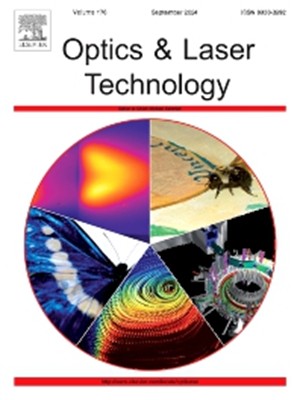High color rendering index white laser light source based on RGBY four primary colors
IF 4.6
2区 物理与天体物理
Q1 OPTICS
引用次数: 0
Abstract
The white laser light source, renowned for its high energy concentration, superior color rendering, and exceptional luminosity, is poised to become a leading choice for next-generation lighting and display technologies. This research presents the synthesis of a superior white laser light source, leveraging RGBY (red, green, blue, and yellow) four-primary-color laser components and advanced wavelength beam combining techniques. The synthesized white laser exhibits a color temperature of 6642 K and a color rendering index (CRI) of 90, Compared to the white light source synthesized using the traditional three-primary-color semiconductor laser method, the color rendering index has seen a significant improvement. The deviation from the standard white light D65 in color temperature is less than 2.1 %. The inclusion of a yellow laser component is critical, effectively bridging the spectral gap and enhancing spectral continuity, thereby significantly improving CRI. This work substantiates the efficacy of four-primary-color semiconductor lasers in white laser synthesis, particularly beneficial for premium lighting and high-definition display applications. It offers novel perspectives on laser utilization in solid-state lighting advancements.
求助全文
约1分钟内获得全文
求助全文
来源期刊
CiteScore
8.50
自引率
10.00%
发文量
1060
审稿时长
3.4 months
期刊介绍:
Optics & Laser Technology aims to provide a vehicle for the publication of a broad range of high quality research and review papers in those fields of scientific and engineering research appertaining to the development and application of the technology of optics and lasers. Papers describing original work in these areas are submitted to rigorous refereeing prior to acceptance for publication.
The scope of Optics & Laser Technology encompasses, but is not restricted to, the following areas:
•development in all types of lasers
•developments in optoelectronic devices and photonics
•developments in new photonics and optical concepts
•developments in conventional optics, optical instruments and components
•techniques of optical metrology, including interferometry and optical fibre sensors
•LIDAR and other non-contact optical measurement techniques, including optical methods in heat and fluid flow
•applications of lasers to materials processing, optical NDT display (including holography) and optical communication
•research and development in the field of laser safety including studies of hazards resulting from the applications of lasers (laser safety, hazards of laser fume)
•developments in optical computing and optical information processing
•developments in new optical materials
•developments in new optical characterization methods and techniques
•developments in quantum optics
•developments in light assisted micro and nanofabrication methods and techniques
•developments in nanophotonics and biophotonics
•developments in imaging processing and systems

 求助内容:
求助内容: 应助结果提醒方式:
应助结果提醒方式:


